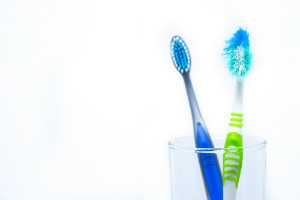Time for a New Toothbrush?
 If it’s been a while since you replaced your toothbrush, it may be time to look for signs of aging. If it is badly worn or frayed, it may be doing more harm than good.
If it’s been a while since you replaced your toothbrush, it may be time to look for signs of aging. If it is badly worn or frayed, it may be doing more harm than good.
If you are unsure about the state of your toothbrush, just bring it in at your next appointment and we can assess the damage, discuss the variety of options, and/or review proper brushing technique.
Old Toothbrush Hazards
- Less Effective – A worn-out toothbrush is simply less effective at removing plaque. A new brush works much more efficiently.
- Risk of Re-infection – Viruses and bacteria love the moist environment of a toothbrush, and some viruses have been shown to remain active for as long as a week after you’re over the flu or a bout with cold sores. Just when you’re feeling better, an old toothbrush can be a source of re-infection. So after an illness, it’s always a good idea to get a new one.
- Risk of Injury – With proper brushing technique, only the very tips of bristles make contact with teeth. When a toothbrush is old and worn, frayed bristles can damage soft tissue. Very hard bristles may even cause gums to recede.
Toothbrush Recommendations
- Soft Bristles – When choosing a toothbrush, soft rounded bristles are ideal to gently polish teeth without causing injury
- Replace Them Regularly – While you may get more or less out of your toothbrush depending on your brushing style, a good rule of thumb is to replace it every 4-6 weeks.
- Use Proper Technique – Place the bristles beside your teeth, angled away from the gums at about 45-degrees. Gently brush teeth using a circular or elliptical motion, a couple of teeth at a time as you gradually cover the entire mouth. Be sure to brush all parts of your teeth (outside, inside, chewing surfaces, and in between) and your tongue as well.
- Get a Second One – Staggering the use of your toothbrush gives it a chance to dry out between uses. This helps prevent fraying and extends its useful lifespan.
![]()
About Yuri Kaneda, DDS
Dr. Yuri Kaneda was born in Japan and immigrated to the US when she was 4 years old with her family. She lived in Ohio, Nebraska, and Illinois before finally settling in the San Diego area. A graduate of Bonita Vista High School, she went on to the University of California Berkeley where she obtained her Bachelors in Microbiology and Immunology. After working for 2 years in growth plate research at University of California San Diego, she went to the University of California San Francisco Dental School for her Doctor of Dental Surgery degree. Upon graduation, she returned to San Diego where she worked as an associate in the practice of Drs. Morimoto and Yaryan, her childhood dentist. She then started her own practice in 1995 and has been at her present location since 1999 which happens to be across the street from her high school!
View all posts by Yuri Kaneda, DDS →
Appointments
To schedule an appointment please email us at [email protected].

